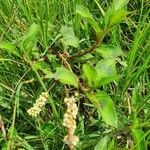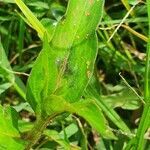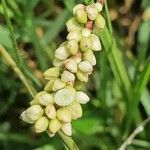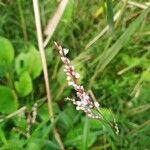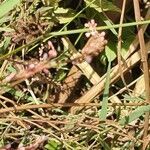Slender, annual herb, helophyte, 0.2-1.0 m high; stems longitudinally grooved. Ocreae tubular, brownish, membranous, ± 20 mm long, with ascending bristly hairs, upper margin fringed with patent bristles. Leaves petiolate, apex acuminate; glabrous, midvein and margins strigose. Inflorescence zigzag when immature, total length up to 155 mm, 2-5 from upper ocreae. Bracts truncate-rounded, terminal margins fimbriate. Flowers 1-3 per bract. Perianth 5-lobed, rose pink. Stamens 6-8, included. Ovary 3-angled. Flowering time Oct.-May. Fruit a trigonous, glossy nut.
Perennial herb; stems decumbent or erect. Leaves sessile or subsessile; blade narrowly linear-ovate to linear-elliptic, base narrowing into petiole, apex acute; lower surface with appressed hairs on midrib and margins only. Ocrea without a spreading herbaceous limb; with a terminal fringe of bristles; hairy. Flowers: peduncles without stalked glands; inflorescence branches glabrous; perianth white or pink; Dec.-Mar. Fruit a trigonous or biconvex nut, smooth.
Erect or decumbent, slender annual or perennial, up to ± 700 mm tall. Leaves narrowly lanceolate-elliptic, margin ciliate sheathing stipules membranous, brown, truncate, thinly covered with short bristle-like hairs and fringed with stiff bristles 10-12.5 mm long. Flowers in a raceme, deep to pale pink or white.
Flowers pedicellate, 2–6 in fascicles surrounded by bracts, arranged in ± terminal spiciform racemes; racemes 2.5–8.5 cm long, 2 or more together, sometimes digitate, slender with a markedly zigzag appearance when immature; peduncles glabrous.
Leaves sessile or subsessile, 7–15 × 0.5–3 cm, linear-lanceolate to linear-elliptic, acute at the apex, attenuate at the base, glabrous, or more rarely papillose or pubescent, with stiff hairs on the margins and on the lower surface midrib.
Ocrea brown, scarious, up to 2 cm long, rather thinly covered with closely ascending bristly hairs, apex truncate with a fringe of whitish-yellow erect-patent stiff bristles 8–15(20) mm long.
Annual herb, up to 400 mm tall. Ocreae fringed with rigid bristles. Inflorescence with a zigzag axis. Flowers purple, deep pink to pale pink.
Stamens 5–8; filaments up to 1 mm long, filiform, inserted near the base of the tube; anthers pink, 0.2–0.25 mm long, ovate.
Bracts reddish-brown, glabrous, truncate or ± rounded at the apex with a fringe of rigid bristles c. 1 mm long.
Perianth white or pink, 1.8–3(3.5) mm long; lobes 5, longer than the tube, oblong-ovate, obtuse at the apex.
Stems green becoming brown below, up to 1 m tall, simple or branched, rooting at the lower nodes.
A glabrous to glabrescent, erect or ± decumbent, sometimes straggling, perennial herb.
Ovary 1.2 × 0.8 mm, ovoid; styles 3, 0.8 mm long, united for half their length.
Nut black, smooth, shiny, 2–3 mm long, trigonous or lenticular.
